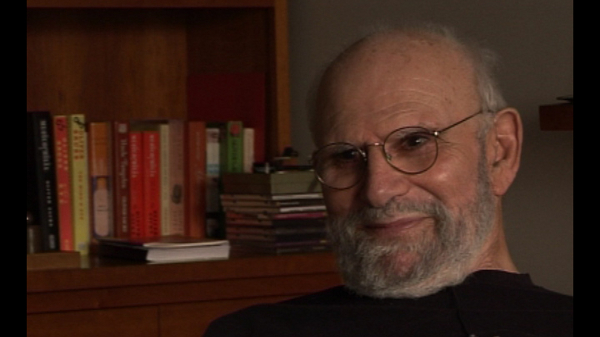NEXT STORY

The final compilation for The Mind's Eye
RELATED STORIES

NEXT STORY

The final compilation for The Mind's Eye
RELATED STORIES


|
Views | Duration | |
|---|---|---|---|
| 311. 'Take the eye if you must, but leave the rest of me alone' | 208 | 06:58 | |
| 312. The profoundest case of amnesia ever seen | 1 | 869 | 02:40 |
| 313. How Musicophilia expanded | 172 | 02:51 | |
| 314. The two pieces from 'Musicophilia' in the 'New Yorker' | 154 | 01:55 | |
| 315. Reception to Musicophilia | 144 | 01:33 | |
| 316. The piano is important once more in my life | 1 | 721 | 03:08 |
| 317. 'I have no excuse not to practise the piano!' | 475 | 02:11 | |
| 318. The events that led up to The Mind's Eye | 155 | 04:52 | |
| 319. Pulling together all the stories for The Mind's Eye | 129 | 03:20 | |
| 320. The final compilation for The Mind's Eye | 125 | 02:35 |


So then it came to me that it was time, having written a book on music, to put some of these many visual things together. There was Lilian Kallir who... who could see the smallest things, but... but could no longer recognise them. There was Stereo Sue who had got this wonderful third dimension at a time when it seemed against the rules to get it, and even Pat was somewhat visual because for her, seeing people’s gestures, was crucially important. I had my Mind’s Eye essay and I was also thinking about hallucinations. And again, I had what had then swollen to 90,000 words of my own melanoma journal, my own visual journal which (unlike any other journal I’d kept before and I... I’d been keeping journals since I was 14) was full of funny little drawings or diagrams of what was happening to my vision. For example, at one time with the right eye – but this bled even into... into both eyes – this, sort of, distortion. People turned into immensely elongated, angular figures tilted to one side. They looked like, sort of, strange... people started looking in this way like strange insectoid figures or, in particular, the Selenites whom HG Wells describes in The First Men In The Moon, so I had a little picture in my notebook of a, sort of, plump human being, being attenuated and tilted into one of these things. The distortions were so gross that it was actually a relief to lose all vision in that eye, because what vision I had, had become grotesque.
So I felt I might have a book putting all of these things together plus hallucinations which I had been writing about, the hallucinations of the blind... which was something which had interested me very much, which I had been going to write about in The Man Who Mistook His Wife For A Hat and perhaps would’ve written about had I not had my accident. I had the name of this blind patient written on my hand, I was going to see her. In 2006... so many things happened at the same time. I saw another patient at the Little Sisters, whom I continue to see, I still go to the Little Sisters. This woman is now, I think, in her 98th year, a... a very bright blind woman who... who has hallucinations. Sometimes blind people develop very heightened imagery and sometimes they may develop visual hallucinations. The... the visual brain won’t die quietly, it’s got to be active.
Oliver Sacks (1933-2015) was born in England. Having obtained his medical degree at Oxford University, he moved to the USA. There he worked as a consultant neurologist at Beth Abraham Hospital where in 1966, he encountered a group of survivors of the global sleepy sickness of 1916-1927. Sacks treated these patients with the then-experimental drug L-Dopa producing astounding results which he described in his book Awakenings. Further cases of neurological disorders were described by Sacks with exceptional sympathy in another major book entitled The Man Who Mistook His Wife For A Hat which became an instant best seller on its publication in 1985. His other books drew on his rich experiences as a neurologist gleaned over almost five decades of professional practice. Sacks's work was recognized by prestigious institutions which awarded him numerous honours and prizes. These included the Lewis Thomas Prize given by Rockefeller University, which recognizes the scientist as poet. He was an honorary fellow of both the American Academy of Arts and Letters and the American Academy of Arts and Sciences, and held honorary degrees from many universities, including Oxford, the Karolinska Institute, Georgetown, Bard, Gallaudet, Tufts, and the Catholic University of Peru.
Title: Pulling together all the stories for "The Mind's Eye"
Listeners: Kate Edgar
Kate Edgar, previously Managing Editor at the Summit Books division of Simon and Schuster, began working with Oliver Sacks in 1983. She has served as editor and researcher on all of his books, and has been closely involved with various films and adaptations based on his work. As friend, assistant, and collaborator, she has accompanied Dr Sacks on many adventures around the world, clinical and otherwise.
Tags: The Men in the Moon, The Man Who Mistook His Wife For A Hat, The Mind's Eye, Lilian Kallir, Stereo Sue, HG Wells, Susan R Barry
Duration: 3 minutes, 20 seconds
Date story recorded: September 2011
Date story went live: 02 October 2012